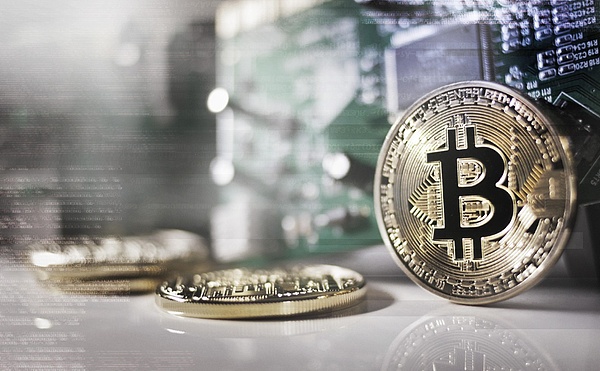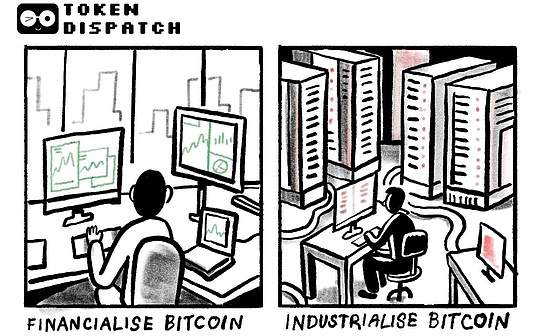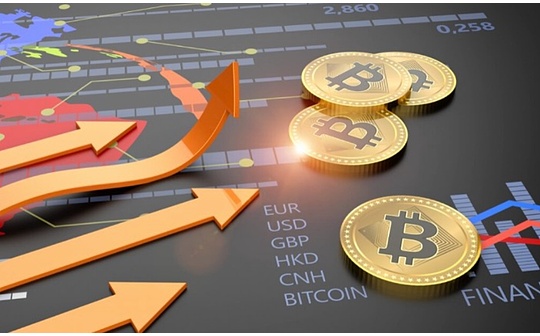
Author profile: Deng Jianpeng, professor and doctoral supervisor of the School of Law of Central University of Finance and Economics, director of the Center for Rule of Law of Financial Technology; Ma Wenjie, doctoral student of the School of Law of Central University of Finance and Economics.
This article was first published in Journal of Shandong University (Philosophy Edition) in 2025.
summary
As crypto assets flourish, global regulatory paradigms are accelerating their differentiation.Developed economies represented by the European Union, the United States, the United Kingdom and Hong Kong, China are actively formulating or updating relevant regulatory policies.China has adopted a “comprehensive ban” regulatory strategy in the field of crypto assets, which has temporarily curbed domestic speculation and prevented financial risks.However, in the face of the rapid evolution of crypto asset ecology and international regulatory policies, prohibited supervision is difficult to be realistic and feasible. The structural conflict with the development of global crypto assets is becoming increasingly obvious, which may curb blockchain financial innovation and wealth effects, which may lead to serious insufficient protection of legal holders’ rights and interests and weaken my country’s voice in the formulation of international rules.my country can take into account financial efficiency while ensuring financial security, re-examine the economic functions and strategic value of crypto assets, and promote the evolution of regulatory policies to a phased “moderate opening”.Specifically, classified supervision can be implemented based on the risk characteristics of crypto assets, crypto asset activities can be included in the compliance regulatory framework, and crypto asset reserves can be included in the national new economic development strategy considerations, occupying the commanding heights in the new round of global digital financial competition, and promoting China to become a financial power.
Keywords:Crypto assets; Bitcoin reserves;Stablecoins; classified supervision; financial power
Summary of opinion
In recent years, the global crypto asset market has entered a rapid development track, rapidly evolving from a marginal field to an important part of the global financial system and investment field.Developed economies such as the United States, the European Union, the United Kingdom, Japan, Singapore, the United Arab Emirates and Hong Kong have formulated or are formulating regulatory policies for crypto assets to incorporate them into their new economic development strategies.The EU Crypto Asset Market Supervision Act, which came into effect in 2024, implements risk-classification and classification supervision on crypto assets.In 2025, the US government announced the establishment of Bitcoin strategic reserves and US digital asset reserves, and realized the Guiding and Establishing National Innovation for U.S. Stablecoins Act (hereinafter referred to as the “GENIUS Act”) formally legislated at the federal level, requiring stablecoins to use US dollars or short-term US bonds as funding reserves.The Hong Kong Special Administrative Region of China began to implement the ETF practice of mainstream crypto asset exchange licenses and Bitcoin and Ethereum in 2024, and passed the “Stablecoin Bill” in 2025.

China’s financial regulatory authorities have previously successively established a prohibited regulatory framework, regarding crypto asset-related transactions as “Notice on Preventing Bitcoin Risks” (2013), “Notice on Preventing the Risk of Token Issuance and Financing” (2017), “Notice on Further Preventing and Disposing of Speculative Risks of Crypto Asset Trading” (2021), and guiding cases No. 199 of the Supreme People’s Court, jointly established a prohibited regulatory framework, regarding crypto asset-related transactions as “illegal financial” activities, prohibiting the denomination of legal currency as Bitcoin, prohibiting Bitcoin “mining”, and clearing and cracking down on the entire industrial chain of crypto assets.Prohibited policies have effectively curbed the domestic speculation and speculation of crypto assets and prevented related financial risks, but with the evolution of the market, their controversy gradually emerged, attracting the attention of a few researchers: on the one hand, judicial organs are affected by the aforementioned administrative normative documents and vaguely identified and swayed the legal attributes of crypto assets.On the premise that there is no formal legislation to deny the legality of crypto assets, there is a serious lack of protection of civil rights and interests of legal holders of crypto assets. Some civil cases involving crypto assets have been refused acceptance by the court on the grounds of “the risk is borne by themselves”, and a large number of “same case and different judgments” have occurred in civil and criminal judgments.On the other hand, with the explosive growth of new crypto assets such as stablecoins in recent years, prohibited norms in a single sovereign state are difficult to cope with the challenges of crypto assets and no longer meet the minimum infringement effect of financial regulation.
Especially since 2025, developed economies represented by the United States have included crypto assets in their new economic development strategies, re-examined and adjusted their regulatory strategies for crypto assets, and introduced special legislation for stablecoins, aiming to gain a competitive advantage in the new round of blockchain finance “arms race”.The global crypto asset industry is experiencing rapid “business innovation” and “rule reconstruction”.Against this background, the structural conflict between my country’s prohibited supervision and the development of global crypto assets is becoming increasingly obvious, and it may no longer comply with the financial regulatory requirements of the “proportional principle”. This key issue has not yet received full attention from domestic financial supervision and legal researchers.”If the law changes with the times, the governance will be effective, and if the governance is suitable for the world, it will be effective.”How to adjust my country’s policies in a timely manner in light of the development trend of crypto assets in the international community and build a crypto asset regulatory framework that takes into account financial security and innovation inclusiveness is a strategic issue that China needs to think about urgently.Compared with domestic research, this article’s innovation will be mainly reflected in two aspects: First, the material effectiveness is new, and a systematic review of the ecological development, innovation of crypto assets related to the new national supervision policies of developed economies in recent years, and analyzing its trends and policy points.Second, propose clear optimization paths with high practical value for existing regulatory policies.The essence of prohibited supervision is the continuation of the “financial suppression” policy. It has some limitations in financial development and innovation, financial consumer rights protection, and the right to formulate international governance rules. This article will propose a policy adjustment from “comprehensive prohibition” to “moderate opening” in terms of theoretical discussion and practical paths.
1. Concept of crypto assets and regulatory requirements
(I) The concept and ecology of crypto assets
At present, there is no internationally formed a completely unified conceptual consensus and classification of crypto assets. Crypto assets are often mixed with concepts such as virtual currencies, private digital currencies, virtual assets, digital assets and tokens.However, international organizations such as the Financial Stability Committee (FSB), the International Monetary Fund (IMF) and the Basel Banking Regulatory Commission (BCBS) have mostly used the expression of “crypto assets” in recent years.This article uses the expression of “crypto assets” and does not distinguish it from the “virtual currency” in my country’s regulatory normative documents. It refers to assets such as Bitcoin, Ether, and Tether that have non-monetary authorities issued, used encryption technology and blockchain distributed accounts or similar technologies, and exist in digital form.

Bitcoin, born in 2009, is a typical decentralized privately issued crypto assets.Bitcoin has the characteristics of decentralized point-to-point value transfer based on shared public ledgers (public blockchains using distributed ledger technology), and is not supported by any assets. Its original purpose is to coordinate the incentive mechanism of network participants to achieve transactions without trusted third parties between individuals, and solve the technical problem of “double spending”.After the birth of Bitcoin, the crypto ecosystem expanded rapidly, and by attracting new market participants, a self-reinforcement cycle has been formed, which has promoted the price of crypto assets to rise.Centralized exchanges play a key role in guiding funds into crypto assets, promoting the exchange between crypto assets and fiat currencies.Subsequently, Ethereum was launched in 2015. Its core innovation is the introduction of smart contracts, allowing developers to deploy various decentralized applications on the chain, implement conditionally triggered automated transaction execution, and promote the prosperity of decentralized finance (DeFi) .Decentralized finance is a new ecosystem of crypto services that improve transparency and reduce financial intermediaries to reduce costs.The decentralized financial protocol combines multiple smart contracts to provide loans, borrowing and transaction services within the crypto ecosystem.Crypto asset holders can use assets such as Ether to engage in decentralized financial transactions, lending and other financial activities.At the same time, stablecoins are a key component of decentralized finance. They remain relatively stable with the anchored fiat currency price and assume the payment and trading media functions of fiat currency in the crypto ecosystem.
(II) Risks and regulatory motives of crypto assets
The “shadow finance” function of crypto assets and decentralized finance is similar to many loopholes in traditional financial markets, and also brings new challenges to existing financial regulation.The regulatory motives and goals of the crypto market mainly include maintaining national financial security and protecting the rights and interests of financial consumers; maintaining the stability of the financial market, and combating financial crimes such as fraud, manipulation, money laundering and terrorist financing.
First, crypto assets challenge the fiat currency system, especially stablecoins anchored by the US dollar may bring the risk of substitution of fiat currencies in other countries and accelerate the cross-border flow of capital.Crypto assets objectively bypass the existing fiat currency system, banking system and third-party payment system, and establish a brand new currency and payment system.The International Monetary Fund uses “cryptoisation” to refer to the replacement of crypto assets for domestic fiat currencies.That is, investors in some countries hold a large amount of crypto assets, and crypto assets (mainly US dollar stablecoins) replace local currencies.These stablecoins are replacing their own currencies and assets and bypassing exchange rate and capital control restrictions.This will reduce the monetary authorities’ regulation of liquidity in the economy, affect the transmission channels of monetary policy, weaken the effectiveness of monetary policy, and may even spread to other regulated entities or the real economy, causing systemic risks.
Second, crypto assets are prone to act as tools for illegal crimes and face difficulties in holding them accountable.Products and services such as crypto assets, coin mixers, decentralized platforms and exchanges, and privacy wallets have emerged in the crypto asset ecosystem. These tools reduce the transparency of financial flows and aggravate information confusion, promoting tax evasion, money laundering, terrorist financing, fraud and market manipulation risks.Compared with traditional financial transactions, there are a large number of off-chain information gaps in crypto assets and decentralized finance. For example, the identity of developers and traders, technical background, compliance records, etc. are often hidden, and users cannot identify their reputation or behavioral motivation, which significantly magnifies the risk of information asymmetry.In addition, the characteristics of blockchain’s “decentralization” are completely opposite to the “centralization” pattern of the financial regulatory system, and it is difficult for supervision to control risks through traditional financial intermediaries as a “grabbing tool”.The anonymity of crypto assets and cross-border transactions have made it difficult to regulate and track, and investors’ funds face great risks, posing important challenges to regulators and law enforcement agencies.
Third, crypto assets may enhance financial risks.One of the most popular uses of crypto assets is for investment (speculation) and trading (hype).The issuance, trading, redemption and storage market of crypto assets and its related products, tools, intermediaries, applications and technologies have seen explosive growth, and the scale of retail and institutional use has expanded significantly.The scope of global crypto asset investors is constantly expanding. According to the data of the “2024 Crypto Wealth Report” jointly released by British consulting company Henley and Partners, the crypto asset market has experienced significant wealth creation and scale expansion, and has achieved overall expansion in the number of wealthy people, the total number of users and the overall market value.As of the end of June 2024, there were 560 million crypto asset users worldwide, and the number of holders holding more than US$1 million crypto assets reached 172,300.With the rapid growth of participation and volume of the crypto market, crypto assets have gradually deepened their relationship with traditional finance and the real economy, and their potential spillover effects of financial stability have aroused high vigilance of regulators.The failure of key service providers in the crypto asset ecosystem, such as crypto asset exchanges, quickly passes risks to other parts of the ecosystem.The price of crypto assets is unstable, and it is easy to amplify financial systemic risks with leveraged trading, liquidity mismatch and interconnection with traditional financial systems.The above challenges and risks strengthen the need for global regulation of crypto assets.
2. Global regulatory trends of crypto assets
The rapid expansion of the crypto asset market has caused concerns about the incomplete protection mechanism for financial consumer rights and impact on financial stability. Global financial regulators are accelerating the legislative process for crypto asset-related activities.Among the new trends in crypto asset supervision, the regulatory practices in the following countries or regions deserve great attention.
(I) The core connotation of the new regulatory policy for developed economies
First, the EU’s unified legislation and risk grading supervision.In May 2023, the European Council voted to approve the Markets in Crypto Assets (hereinafter referred to as “MiCA”).MiCA provides a comprehensive regulatory framework for the EU crypto asset market.According to the idea of classified supervision, MiCA has made detailed provisions on the definition and use of crypto assets, the access license of crypto asset issuers and service providers, the operation and management of crypto asset issuers and service providers, the reserve and redemption management of crypto asset issuers, and the anti-money laundering supervision of crypto asset trading activities, etc., and is by far the most comprehensive crypto asset supervision regulations in the world.MiCA divides crypto assets into Asset-Reference Tokens (EMT), E-money Tokens (ART) and other crypto assets, and sets differentiated regulatory rules.Among them, electronic currency (EMT) and asset reference tokens (ART) are the main types of crypto assets regulated by MiCA.It is worth noting that MiCA does not cover crypto assets such as DeFi, NFT and security tokens that meet other regulated tools, nor does it cover the central bank’s digital currencies (CBDCs).In terms of regulatory objects, MiCA mainly regulates the establishment and business activities of crypto asset issuers and crypto asset service providers.
Second, the United States’ crypto asset promotion policies and strategic reserve plans.In March 2022, the United States issued the Executive Order on Ensuring Responsible Development of Digital Assets, establishing the development strategy of US digital assets at the federal level, supporting digital asset development, and positioning the United States as a leader in blockchain innovation and digital asset technology.The U.S. Securities and Exchange Commission (SEC) approved Bitcoin spot and Ether spot ETFs in 2024, attracting capital inflows from a large number of traditional investment institutions.In January 2025, the new US President Trump signed an executive order to strengthen the United States’ leadership in the field of digital financial technology, announcing the construction of a new digital asset supervision system, requiring the protection of public chain access and freedom of digital assets, establishing the president’s “Digital Asset Market Working Group”, managing the issuance and operation of US digital assets, setting up a new “Digital Assets Committee”, banning the issuance of central bank digital currency, promoting the study of legislative matters such as Bitcoin strategic reserves, and building the United States into the “world capital of cryptocurrencies.”
In March 2025, Trump signed an executive order, announcing the establishment of a strategic Bitcoin Reserve and the U.S. Digital Asset Stockpile, including the confiscated approximately 200,000 Bitcoins in the national reserves, and forming a “dollar-stablecoin-crypto market” cycle by supporting US dollar stablecoins (such as USDT and USDC), strengthening the US dollar’s valuation status in global crypto asset trading.In July 2025, the U.S. Congress finally voted to pass the National Innovation Act to Guidance and Establish a Dollar Stable Coin and will come into effect after signing it by the president, setting clear rules for US dollar-backed stablecoins in terms of issuance, legal reserves, transparency and regulation to stabilize the mechanism for the pegging of digital stablecoins to the US dollar.At the same time, the U.S. House of Representatives passed the Digital Asset Market Clarity Act of 2025, referred to as the “CLARITY Act” for short.The bill subdivides digital assets into digital commodities, investment contract assets and non-commodity collectibles, clarifying the disputes in the attributes of crypto assets, and clarifying the regulatory structure, that is, the CFTC is responsible for the spot market of digital commodities, and the SEC is responsible for securities issuance and anti-fraud enforcement.The U.S. government supports the policy main line of compliance and innovation in crypto assets, and at the same time incorporates the crypto market into the U.S. financial system and binds it to the U.S. dollar system (USD and Treasury bonds).The bill uses stablecoins to strengthen the US dollar’s position in the international monetary system, improve global acceptance and demand for the US dollar, promote the United States to control the future of digital finance, and strengthen the US financial dominance. Its strategic intention is worthy of my country’s attention.
Third, Hong Kong, China’s crypto-asset-friendly policy.In October 2022, as an important financial opening window for my country, the Hong Kong SAR Government issued the “Policy Declaration on the Development of Hong Kong Virtual Assets”, explaining the macro policies and development directions of crypto assets in Hong Kong under the trends of distributed ledgers (DLT) and Web 3.0.At the same time, principled ideas are put forward for the sandbox supervision of crypto assets such as non-homogeneous tokens (NFTs), digital issuance of green bonds, and digital Hong Kong dollars.The Financial Affairs and Treasury Bureau of the Hong Kong Special Administrative Region Government (FSTB) issued the “Policy Declaration on the Development of Virtual Assets in Hong Kong” in October 2022, clarifying the regulatory vision and policy direction for virtual/digital asset activities under the principle of “same business activities, same risks, same supervision”.In June 2023, the Hong Kong Special Administrative Region Government established a working group to promote the development of Web3.Since 2024, the Hong Kong Special Administrative Region has changed its previous strict regulatory trend and implemented a license system for mainstream crypto assets (Bitcoin and Ethereum) transactions. Securities tokens are subject to the Securities and Futures Ordinance. Non-security tokens are included in anti-money laundering supervision, and has successfully explored the listing and trading of Bitcoin and Ethereum.In May 2025, the Legislative Council of the Hong Kong Special Administrative Region passed the “Stablecoin Bill” to establish a licensing system for issuers of legislative currency stablecoin in Hong Kong, China, and the plan will be implemented on August 1.In June 2025, Hong Kong issued the “Hong Kong Digital Asset Development Policy Declaration 2.0”, which proposed the “LEAP” framework of four major strategies, including optimizing law and regulation, expanding tokenized product types, promoting application scenarios and cross-sector cooperation, and the development of talents and partners. It also clearly regularizes the tokenization of government bonds, promotes the tokenization of real-world assets such as precious metals, non-ferrous metals and renewable energy, and reiterates that Hong Kong will be built into a global innovation center in the field of digital assets.

(II) Analysis of policy characteristics of developed economies
In July 2023, the Financial Stability Committee (FSB) drew on the experience of implementing international standards by institutions in various jurisdictions and released the final report of the FSB Global Regulatory Framework for Crypto-asset Activities, and put forward the overall principles of regulatory recommendations: First, the principle of “same business, same risks, same supervision”.If the crypto asset business has the same economic functions as traditional financial businesses and is accompanied by the same type of financial risks, the same regulatory requirements should be followed.The second is the principle of flexibility.Regulators in various economies can apply existing laws and regulations to the crypto-asset industry or formulate new laws and regulations to implement relevant regulatory recommendations.The third is the principle of technical neutrality.Regulatory authorities in each economy should regulate based on the economic functions and risk characteristics of crypto asset business, rather than their underlying technology.Based on the above international standards, developed economies have issued relevant proposals or formal legislation on crypto asset-related activities, which reflect the following characteristics as a whole.
First, crypto-friendly regulatory attitude and framework.In the early stages of crypto assets development, there were differences in regulatory policies among countries, and the focus on the balance of innovation and risk is different.However, recently, developed economies have re-examined and adjusted their regulatory strategies for crypto assets, and actively guided and created a crypto asset-friendly regulatory attitude and framework.US President Trump has undergone a major shift in his attitude towards non-sovereign cryptocurrencies such as Bitcoin, from “Bitcoin is a scam that competes with the US dollar” to “Bitcoin will not pose a threat to the US dollar”, and adopts a positive and inclusive policy on crypto assets.The Trump administration explicitly abolished the previous Digital Assets Executive Order and the Treasury Department’s Framework for International Engagement on Digital Assets, believing that these bills suppress innovation and undermine the U.S. economic freedom and global leadership in digital finance.The regulatory policies of developed economies have shifted from fragmented rules to systematic frameworks, showing a crypto-asset-friendly policy attitude, attracting funds or capital agglomeration by increasing policy certainty.
The second is to strengthen compliance requirements for anti-money laundering and anti-terrorist financing (AML/CFT).Anti-money laundering and combating terrorist financing are core elements of crypto asset regulation. Regulators in developed economies usually use the standards of the Financial Action Task Force on Money Laundering (FATF) and use crypto asset service providers as regulatory tools, requiring strict implementation of anti-money laundering and anti-terrorist financing measures.In June 2019, the Anti-Money Laundering Financial Action Task Force updated its Recommendation No. 15 and its Explanation Notes, and issued the Guidance for a Risk-Based Approach for Virtual Assets and Virtual Asset Service Providers, applying anti-money laundering and anti-terrorist financing related measures to virtual assets (VA) and virtual asset service providers (VASP).One of the key requirements is the “travel rules”, which require countries to ensure that the initiator’s virtual asset service providers can instantly and securely obtain, hold and exchange information of the transaction remitter and payee when conducting transactions, and safely transmit it to the recipient’s virtual asset service provider or related financial institutions if necessary.The recommendations of the Anti-Money Laundering Financial Action Task Force on the Anti-Money Laundering Supervision of crypto assets are regarded as the weather vane of the anti-money laundering laws of various countries. Developed economies such as the United States, the European Union, Japan, and Singapore have strengthened the promotion of anti-money laundering supervision of crypto assets through institutional unification and law enforcement, and gradually established a compliance system foundation with virtual asset service providers as the focus.The “Special Update on Implementation of Virtual Assets and Service Providers Standards” released by the Anti-Money Laundering Financial Action Task Force in 2025 shows that in the 2025 survey, 73% of the jurisdictions surveyed (85 of the 117 jurisdictions, excluding those that explicitly prohibit or plan to prohibit VASP) passed legislation to implement the “travel rules”.
The third is to emphasize classified supervision based on risks.Developed economies mainly refer to or follow the principle of “same business, same risks, same supervision” proposed by the Financial Stability Committee.A common classification method is to refer to crypto assets with a stable mechanism as “stablecoin” based on whether they try to stabilize their value by referring to other assets. Crypto assets with a stable mechanism are called “stablecoin”, and crypto assets without a stable mechanism are called “unbacked crypto-assets”.For stablecoins with currency stability mechanisms, MiCA divides them into two categories according to the different underlying assets, namely asset reference tokens (anchored to one or more fiat currencies, commodities, crypto assets or combinations of the above assets) and electronic currency tokens (anchored to one fiat currencies), and set differentiated regulatory rules.In addition, many countries or regions actively promote the application of the securities law in the field of crypto assets, distinguishing crypto assets with financial instrument characteristics (including securities) from other crypto assets. The former is sometimes called “securities tokens”, and the same supervision as financial instruments and securities issuers can be considered.The Swiss Financial Market Regulatory Authority (FINMA)’s first token issuance (ICO) regulatory framework in 2018, which divides crypto assets into three categories: payment tokens, utility tokens, and asset tokens.According to different functions, the Swiss Financial Markets Authority defines payment tokens as “non-securities” payment method, which is more similar to currency; asset-based tokens are defined as “securities” close to financial products, while practical tokens distinguish their attributes based on whether they have additional investment purposes, and different regulatory frameworks are applied respectively.Of course, the above classification is not clear. For example, the Securities and Futures Commission of the Hong Kong Special Administrative Region of China (SFC) pointed out that the terms and characteristics of crypto assets may evolve over time, and non-security tokens may be converted into securities tokens, and vice versa. It also recommended that crypto asset service providers should apply for licenses related to the two types of assets on the ground of “prudent”.
3. Characteristics and limitations of my country’s prohibited policies
(I) Phase evolution of prohibited policies
The potential risks of crypto assets make the intervention of financial regulatory authorities necessary.my country has expanded the scope of application of prohibited supervision in a phased manner, as follows.
The first stage is the risk warning stage.In order to protect public property rights and interests and prevent money laundering risks, in December 2013, the People’s Bank of China and other departments issued the “Notice on Preventing Bitcoin Risks” (Yinfa [2013] No. 289), clarifying that Bitcoin is not a currency, but a specific virtual commodity.Bitcoin trading is a commodity trading act on the Internet, and ordinary people have the freedom to participate on the premise of taking their own risks.Regulators generally took a wait-and-see attitude in the early stages of crypto assets development, acknowledging Bitcoin’s legal property status, and allowing on-site and off-site transactions to be limited.
The second stage is the key risk rectification stage.In 2017, Initial Coin Offering (ICO) was popular all over the world, and many projects raised funds by issuing tokens on Ethereum.In the initial token issuance, the initiator sells a certain token (crypto assets) to the investor group and absorbs mainstream crypto assets such as fiat currency or Bitcoin.Crypto assets issued through ICOs are similar to traditional stocks or debt certificates, and holders have the right to claim specific property rights from the issuer, so they are also called “security tokens” and “utility tokens”.However, in most cases, unregulated and unconstrained IC token issuance is mostly alienated into a means for scammers to engage in illegal financial activities.Initial token issuance is generally suspected of illegally absorbing public deposits or fundraising fraud. The initiator pushes up the price of tokens and then sells it quickly to make a profit. Those who buy tokens lose a large amount of principal.In September 2017, the “Announcement on Preventing the Risk of Token Issuance and Financing” issued by the People’s Bank of China and other ministries and commissions clearly stated that no organization or individual shall illegally engage in token issuance and financing activities. All types of token issuance and financing activities should be stopped immediately, financial payment institutions are prohibited from participating in crypto asset business, and domestic exchanges are required to be cleared, and related financial risks will be controlled in the short term to have obvious results.
The third stage is the complete ban stage.In May 2021, the Financial Stability and Development Committee of the State Council held its 51st meeting, proposing to resolutely prevent and control financial risks and crack down on Bitcoin’s “mining” and trading behavior.Follow-up regulatory policies will quickly implement the spirit of the above meeting.In September 2021, the National Development and Reform Commission and other departments issued the “Notice on the Remediation of Virtual Currency “Mining” Activities”, which listed mining activities as an elimination industry, strictly prohibited new mining projects, and strengthened strict supervision of the upstream and downstream industrial chains of crypto asset “Mining” activities.The “Notice on Further Preventing and Disposing of Speculation Risks in Virtual Currency Transactions” issued by the People’s Bank of China and other ministries and commissions in September 2021 emphasized that crypto-asset-related business activities are illegal financial activities and are strictly prohibited and resolutely banned in accordance with the law. The services provided by overseas exchanges to domestic residents are also included in illegal financial activities.It is worth noting that the publication of the “Notice on Further Preventing and Disposing of the Risk of Speculation in Virtual Currency Transactions” has added the Supreme People’s Court, the Supreme People’s Procuratorate and the Ministry of Public Security. The financial regulatory rules directly have a huge influence in the fields of law enforcement and judicial trials, and it is clear that any legal person, non-legal person organization and natural person investing in crypto assets and related derivatives that violate public order and good customs shall be invalid, and the losses caused by this shall be borne by them.
In February 2022, the Supreme People’s Court revised the “Interpretation on Several Issues Concerning the Specific Application of Laws in the Trial of Criminal Cases of Illegal Fundraising” (Fashi [2022] No. 5), clearly listing “virtual currency transactions” as an act of illegally absorbing funds, providing a clear basis for judicial organs to crack down on such crimes.In August 2024, the “Interpretation on Several Issues Concerning the Application of Laws in Handling Criminal Cases of Money Laundering” jointly issued by the Supreme People’s Court and the Supreme People’s Procuratorate clearly listed “transfer and convert criminal proceeds and their income through ‘virtual assets’ transactions and financial asset exchanges” as money laundering for the first time.

my country is vigilant about risks related to crypto assets, and its characterization of crypto assets is relatively negative, and ultimately the overall characteristics of prohibited supervision are shown.Prohibited supervision covers three dimensions: First, the entire industrial chain is prohibited at the administrative supervision level.At the issuance level, it is prohibited to create or issue crypto assets through mining; at the transaction level, it is prohibited that any entity at home and abroad is prohibited to provide crypto asset services such as custody settlement, redemption investment, information consultation, etc. to domestic residents.Second, the criminal level makes it closely connected with illegal and criminal activities.On the basis of administrative regulations clarifying the illegality of crypto asset trading activities, through judicial interpretation, specific crypto asset trading activities are included in the types of criminal activities such as illegal fundraising and money laundering, so as to strengthen the “illegality” of crypto asset-related transaction activities and the “legality” of ban activities.Third, there is no protection at the civil judicial level.The impact of prohibited supervision penetrates and spreads from administrative supervision to judicial level, sending signals to the society about the illegality of crypto asset transactions and risk prevention and control.Regulatory departments or judicial organs tend to determine that civil acts such as entrusted investment in crypto assets are invalid due to violation of public order and good customs, and will not provide relief and protection for the losses of relevant investors, further exert the active effect of financial justice, and strengthen the coordinated governance of financial justice and financial supervision.
(II) Limitations of my country’s prohibited regulatory policies
my country has played an important role in cracking down on domestic related speculation, cracking down on illegal and criminal behaviors involving cryptocurrencies, and controlling financial risks in the phased and gradual expansion of crypto assets.However, with the rapid evolution of the crypto asset ecosystem and international regulatory trends, the limitations of prohibited supervision have become increasingly prominent.
First, there are questions about the legal basis of prohibited regulatory norms.The “Notice on Preventing Bitcoin Risk”, the “Notice on Preventing the Risk of Token Issuance and Financing”, and the “Notice on Further Preventing and Disposing of Speculation Risks of Virtual Currency Trading” constitute the normative basis for crypto asset supervision.From the perspective of the formulation subject and formulation procedures, the above documents were jointly formulated and issued by the People’s Bank of China and other ministries (departments). The legislative procedures are relatively simple and do not meet the high standards for the formulation of rules in the “Regulations on the Procedures for the Formulation of Regulations”. In terms of legal effect, they can only be used as “normative documents below the regulations.”According to Article 80 of my country’s Legislative Law, no provisions or rules of law or administrative regulations shall be empowered, shall not detract from citizens’ rights and freedoms, and shall not increase their obligations.Therefore, normative documents do not have the authority to directly create provisions that reduce citizens’ rights and increase their obligations, otherwise their own legality will be disputed.The “Notice on Further Preventing and Disposing of Speculation Risks in Virtual Currency Transactions” believes that crypto-asset-related business activities “suspected of illegal issuance of token tickets, unauthorized public issuance of securities, illegal business operations of futures business, illegal fundraising and other illegal financial activities” should be “strictly prohibited and resolutely banned in accordance with the law.”In practice, cryptoasset-related business activities are complex. The “one-size-fits-all” illegality and ban regulations on cryptoasset-related business, which excludes the obligation to investigate and hear individual cases, resulting in some legal behaviors being prohibited.At the same time, the prohibition rules deprive market entities of individual freedom to participate in crypto asset transactions, and are suspected of improperly detracting from citizens’ rights, causing hidden legal concerns.
Second, prohibited supervision has failed to effectively protect financial consumer rights, and even aggravated the dilemma of protecting the rights and interests of legal holders of crypto assets.Due to the reservations of policies and the abstraction of the text itself, the norms in the crypto assets field are not systematic, stable and clear as a whole, resulting in differences in understanding regulatory policies in practice.Affected by the strict regulatory attitude, judicial authorities have cognitive biases in the legal attributes of crypto assets, and the judgment documents of the cases show many similar cases and different judgments, which can easily arouse public doubts.Regarding the legal attributes of crypto assets, some courts identify crypto assets as “virtual property” protected by law, while others believe that crypto assets are illegal property or illegal property.In terms of the effectiveness of civil legal acts for crypto assets, there are two views: “effective theory” and “invalid theory”. Especially after the promulgation of the Notice on Further Preventing and Handling the Risk of Speculation in Virtual Currency Transactions in 2021, the court tends to invoke this normative document to determine that the entrusted investment contract of crypto assets violates the “public order and good customs” of Article 153, paragraph 2 of the Civil Code and is deemed invalid.Regarding the issue of discount compensation and execution of crypto assets cases, some arbitration institutions support “replace return with fiat currency”, but the key points of the Supreme People’s Court’s guiding case No. 199 pointed out that the practice of arbitration awarding compensation of fiat currencies with the same value as Bitcoin violates national financial regulatory regulations and social public interests.Although this judgment idea is in line with the regulatory policy orientation of the administrative agency’s comprehensive prohibition of virtual currencies, it is not conducive to the protection and relief of the legitimate rights and interests of crypto asset investors, and even encourages social adverse selection and increase moral risks.At present, my country’s prohibited regulatory policies have led to some judicial organs having a cognitive tendency to “crime speculation” or even “currency-related violations”, which automatically links crypto asset transactions with illegal crimes, and some areas have a wide negative impact on some legal holders of crypto assets. For example, some public security agencies deduct the parties’ crypto assets without legal basis.
In addition, cases in the crypto assets field are “finished” because of their wide public nature, high value of property involved, and often involve crimes such as organizing and leading pyramid schemes, opening a casino, etc.These two factors have led to the increased crackdown on the crypto asset activities by judicial authorities in practice, which can easily induce problems such as “ocean fishing” and “profit-seeking law enforcement”.Some public authorities hand over the confiscated huge amount of crypto assets to third-party companies for sale, causing serious problems such as transfer of interests.The judicial documents of the major online pyramid scheme case of “Plus Token”, known as the “No. 1 Funding Scale in the Currency Circle”, show that after the incident, the investigative agency seized 194,775 Bitcoins, 833,083 Ethereum, etc.The defendant Chen applied to the public security organs to entrust a Beijing technology company to sell crypto assets seized by the public security organs overseas in accordance with the law, and all the funds were used as his return of the stolen money.The funds and income obtained will be confiscated according to law and handed over to the state treasury.This treatment method faces major legality and rationality issues: First, the exchange of crypto assets and legal currency in my country is both illegal financial activities.This provision also restricts state organs, and even if judicial departments intervene in the transaction process, its illegal nature will not change.Second, my country prohibits financial institutions or related platforms from engaging in cryptocurrency business, so it is impossible to find official institutions or professional organizations entrusted to custody in China, but can only seek overseas trading platforms to accept related businesses. This is not consistent with the functional positioning, legal attributes and requirements of my country’s public security and judicial institutions. Moreover, this method lacks effective supervision, which is easy to breed duty crimes and generates interest transfer.
Third, prohibitive regulation has stifled financial innovation in crypto asset formats and the public’s wealth benefits.Although my country’s regulatory policies have curbed risks, they have also hindered the numerous applications of blockchain technology in the fields of cross-border payments (such as stablecoins), real asset tokenization (RWA), decentralized finance and stock tokenization.In addition, financial institutions and technology research and development institutions, as market entities pursuing efficiency, have to shift resources originally used for compliance technology innovation to build overseas architectures under the influence of policy uncertainty, in order to avoid supervision, which may push financial innovation out of the door.Under the general trend of global fiat currency depreciation and capital controls becoming increasingly frequent, mainstream crypto assets have gradually become important global asset allocation tools and personal wealth preservation channels.The United States has clearly established a strategy for reserves of Bitcoin and crypto assets. my country’s prohibited supervision has caused crypto assets to face the haze of “object illegality”, which objectively leads to the loss of this important anchor asset at the individual, enterprise and even the country.Citizens, market entities and even public power agencies in the country have great restrictions in the process of holding, trading, and disposing of crypto assets and face severe institutional obstacles to the legitimacy of monetization. It is difficult to participate in the crypto asset market or share investment returns. It faces development difficulties in the wave of globalized digital assets, which may even seriously affect a country’s citizens’ wealth accumulation and financial returns, and may even affect a country’s financial security.
Fourth, prohibited supervision leads to insufficient participation in international governance and weakened international rule-making power.Many developed countries or regions have formulated or prepared to formulate a regulatory framework for crypto asset classification and actively put it into practice.The MiCA Act clearly states that the EU continues to support the promotion of global collaborative governance of crypto assets and crypto asset services through international organizations such as the Financial Stability Commission, the Basel Banking Regulatory Commission, and the Anti-Money Laundering Financial Action Task Force.The Financial Conduct Authority said it is necessary to learn and interact with international partners and regulators to ensure that the framework developed is closely aligned with international standards.The Financial Conduct Authority played a leading role in the work of crypto assets organized by the International Securities Commission, leading the formulation and implementation of the Policy Recommendations for Crypto Assets and Digital Assets; and in close cooperation with the Financial Stability Commission and the Anti-Money Laundering Financial Action Task Force, it led the special peer review of the global regulatory framework for crypto assets activities.
China has been in a state of strict regulation for a long time and has rarely systematically participated in the formulation of international rules of the International Securities Commission organization, the Financial Stability Commission and the Anti-Money Laundering Financial Action Task Force, and has made limited contributions to the formulation of crypto-related rules.For example, in June 2025, the Anti-Money Laundering Financial Action Task Force released the Best Practices for the Regulation of Travel Rules, providing examples of good practices that jurisdictions can consider when developing regulatory frameworks.However, my country clearly prohibits the activities of crypto assets and their service providers (Has explicitly prohibited the use of VAs and VASPs), making it impossible to implement travel rules, and it is even more difficult to develop best practices for forming travel rules.The Anti-Money Laundering Financial Action Task Force also pointed out the limitations of prohibited regulation in the “Best Practice for the Supervision of Travel Rules”, including “stable currency issuers need to freeze illegal funds, but require jurisdictional regulatory cooperation. Regions that do not implement travel rules (such as some prohibited countries) cannot provide a cooperation framework”, “Journal implementation differences cause crypto asset service providers to review transactions from unimplemented regions (such as China), significantly increasing compliance costs and risk delays.”my country’s prohibited supervision may face the problem of poor institutional adaptability and insufficient international coordination capabilities. Domestic regulatory documents are disconnected from international regulatory trends, which may further squeeze China’s discourse space in this field in the long run.
4. China’s regulatory strategy shifts and improvements
(I) Re-understanding of the strategic significance of crypto assets
Crypto assets have important strategic value in building a financial power.In 2023, the national leaders proposed the key core financial elements of the “six powerful” of financial powers – strong currency, strong central banks, strong financial institutions, strong international financial centers, strong financial supervision and a strong team of financial talents – pointing out the direction for the path of financial development with Chinese characteristics.Under this strategic framework, crypto assets, as an important carrier of the financial technology revolution, have strategic value in enhancing my country’s financial competitiveness.First of all, in terms of promoting the internationalization of the RMB, the Hong Kong regulatory sandbox plan is testing cross-border payments of stablecoins anchored by offshore RMB and other fiat currencies. This innovation allows the RMB to bypass the restrictions of the traditional SWIFT system, realize efficient circulation of “payment is settlement”, improve the efficiency of cross-border trade settlement of RMB, and expand the function of currency carriers. Stablecoins anchored by RMB can enhance the multi-functional functions of the RMB as a denominated currency, payment currency and reserve currency.Establishing an offshore RMB stablecoin system can attract countries along the “Belt and Road” to use it as a tool for trade settlement and reserve assets, form a new path to internationalization of the RMB driven by technology, and turn it into a driving force for the RMB to become a “strong currency.”

Secondly, developed economies such as the United States are trying to lead crypto asset innovation, and China’s prohibition policy may miss the opportunity to build a financial power.Blockchain finance has the characteristics of “de-intermediation”. From stablecoins to real asset tokenization (RWA), they are all financial innovation and development models based on Web3, transcending the traditional bank-led financial intermediary, representing the future model transformation of finance, and may help to give birth to new “strong financial institutions.”China can consider using compliance channels (such as ETFs of mainstream crypto assets) to phase out private capital allocation of crypto assets, expand national strategic reserves in disguise, and avoid lagging behind in the competition for “digital gold”.The legalization of crypto asset transactions will guide “underground finance” to become more prosperous and prevent systemic risks.Some domestic people have a long-term real demand for crypto asset allocation. The reason is that Bitcoin has anti-inflation attributes. After being impacted by the rising global fiat currency inflation rate, its price often rises, similar to the anti-inflation asset function of gold.Bitcoin also has the advantages of constant supply, portability, easy segmentation and not being influenced by the monetary policies of specific countries. Therefore, investors regard Bitcoin as a “digital gold” that hedges the depreciation of fiat currency.We believe that Bitcoin is an “important wealth carrier for the next generation” and is becoming a key accounting unit that carries human wealth. It is also the underlying asset of cyberspace, and may surpass the status of gold.However, the prohibition policy objectively leads to my country’s lack of compliance channels for domestic transactions and investments, causing domestic funds to flow out through gray channels such as offshore trading platforms and over-the-counter trading. Such underground transactions are prone to trigger risks of fraud, foreign exchange, money laundering and capital flight.
The deep embedding and integration of the global crypto asset system and the traditional financial system is becoming a general trend, and it is not subject to the will of a specific individual, institution or country. In the long run, the limitations and negative effects of prohibited supervision are becoming increasingly prominent.The legalization and classified supervision of crypto asset transactions will help achieve transparent supervision of domestic funds, protection of financial consumer rights, and compliance with taxes for crypto asset investment, increase fiscal revenue, and promote financial regulatory capabilities in practice.my country can re-examine the economic functions and strategic value of crypto assets, explore the evolution from “comprehensive ban” to “moderate opening”, and incorporate crypto assets into the track of compliant development.Instead of watching the huge investment demand and the breeding of risks underground, regulators should guide them into a legal framework on the premise of ensuring financial security, monitor the flow of funds in real time, prevent illegal financial activities, and improve investor suitability standards.
(II) Theoretical rethinking of prohibited regulatory policies
The idea of comprehensive prohibition on industries related to crypto asset is not realistic and feasible, nor is it in line with the principles of interest consideration and proportion.Financial supervision is a public law act in which public power interferes with private rights, and should also be bound by the principle of proportionality in public law – the principle of purpose legitimacy, appropriateness, necessity and balance.In terms of regulatory purposes, crypto assets represented by stablecoins show purposeful legitimacy expansion at the level of monetary sovereignty, and prohibited supervision is difficult to cope with the corresponding challenges of currency substitution.In terms of the appropriateness and necessity of means, regulatory authorities can use alternative means to less infringe on private rights through restricting market access and other means. The structural conflict between prohibited supervision and the development of global crypto assets is becoming increasingly obvious.In the principle of balance, prohibitive supervision may curb inclusive finance and financial innovation, resulting in excessive intervention by public authorities in the name of public interests, and it is difficult to achieve a balance between private rights infringement and public interests.With the continuous acceleration of my country’s financial market opening up, the correlation between domestic market and international market financial institutions is deepening, and there is still room for re-examination of inherent policies.
Classic theories and practices of financial supervision show that safety, efficiency and fairness are the core values that financial supervision cannot be neglected.In determining the value goals of financial supervision, Professor Xing Huiqiang proposed the solution to the “three-legged theorem”, using “financial security”, “financial efficiency” and “consumer protection” as the “three-legged” of financial law legislation, financial supervision goals and financial system reform.Professor Feng Guo further improved and developed the “Three-legged Theorem”, expanded “consumer protection” to “financial fairness”, and formed a game model of mutual checks and balances with “financial security”, “financial efficiency” and “financial fairness” as the three legs.But in the field of crypto assets in China, the balance of the above-mentioned diversified policy goals is particularly challenging.Overall, the risk prevention and control strategy of over-reliance on administrative bans stems from the excessive demand for financial security, seriously neglecting financial efficiency, especially the protection of financial consumer rights, and triggering explicit conflicts in the value of multiple regulatory.
Prohibited supervision originates from the fact that crypto assets and blockchain decentralized finance have almost no actual value, which triggers a large number of crimes such as money laundering, pyramid schemes and fraud, and poses major risks to the financial system and consumer rights, and ignores the positive functions and positive values of crypto assets and their ecosystems.From a positive point of view, private crypto assets represented by Bitcoin realize point-to-point (P2P, which the remitter directly sends to the recipient’s wallet) transactions, and payment, settlement and clearing are in place in one step. The significant advantages of this type of mainstream private crypto assets are to streamline the intermediary link, reduce fees, improve efficiency and openness and transparency, and become an important tool to hedge against the risk of long-term depreciation of legal currency.Stablecoins are gradually becoming one of the mainstream revolutionary cross-border payment settlement tools. Compared with the traditional financial payment system, cross-border payment of stablecoins can realize instant clearing between any nodes around the world, with advantages such as point-to-point, 7×24-hour payment, near-real-time transactions, low handling fees and transparent handling advantages.Decentralized finance is becoming an efficient investment and financing tool, trying to replicate traditional financial services and business formats in a decentralized way in the crypto world. This on-chain lending model has the characteristics of licensing without permission, global openness, automated execution, and transparent mortgage rate.Crypto assets themselves and related ecology are not just tools for illegal crimes, but also have the characteristics of inclusive finance and the value of promoting inclusive growth.
We believe that financial security, financial efficiency and financial consumer rights protection are by no means opposite, and are largely a unified and mutually promoting relationship.Financial security that lacks efficiency, costs and kills innovation is fragile.Only when financial regulatory policies can promote innovation and effectively protect the rights and interests of financial consumers can financial security be consolidated.On the one hand, the United States has adopted an inclusive policy, actively adopted crypto asset innovation, strengthened the international dominance of the US dollar with the help of stablecoins, and used Bitcoin as a strategic reserve to build the United States into the world’s crypto assets capital; on the other hand, regulators such as the Securities and Exchange Commission (SEC) have frequently faced blockchain financial companies such as Ripple in recent years, and have strengthened the protection of financial consumer rights through recent relevant legislation, effectively promoting the compliance development of crypto asset practitioners and ensuring national financial security.However, under the prohibition policy, regulatory norms and judicial judgments in the field of crypto assets mostly reflect the trend of “public welfare excellence”, aggravating the embarrassment that legal protection of the rights and interests of legal holders of crypto assets cannot be combined with serious insufficient judicial relief.The current financial regulatory paradigm is undergoing a structural transformation from simple regulation and constraints to innovation empowerment.The traditional binary opposition model between financial innovation and financial supervision has surpassed the traditional binary opposition model. The core goal of supervision is no longer a single regulation, but actively conforms to the development trend of financial innovation and provides a long-term impetus for financial innovation through financial supervision.Based on this, in the process of promoting the crypto asset supervision system, in addition to the dimension of “financial security”, the two long-lost value dimensions, “financial efficiency” and “consumer rights protection”, are focused on re-incorporating the long-term value dimensions of “financial efficiency” and “consumer rights protection” into the scope of consideration in policy formulation to ensure that the above value goals achieve benign interaction.my country can re-examine the functional value of the crypto asset ecology for inclusive finance and financial development, especially focusing on the strategic value of mainstream crypto assets in international finance and political competition, and then accurately determine it at the legal level.
In terms of crypto asset development strategies, my country can seek a prudent balance between innovation promotion and risk prevention, and build a dynamic system based on risk assessment.Some researchers have summarized three courses of action by regulators to deal with risks related to crypto assets: Ban, Contain and Regulate.Apart from the situation where crypto asset activity is completely prohibited, these options are not mutually exclusive and can be used in combination.my country can explore more adaptable regulatory paths on the basis of adhering to the bottom line of risk prevention and control in the future to achieve a balance between normative and development.In terms of the choice of regulatory strategies, my country can evolve from “comprehensive ban” to “moderate opening”, comprehensively use the regulatory strategies of containment and supervision, and incorporate crypto assets into the track of compliance supervision, and gradually transform from developing only “central bank digital currency” to “coordinated development of central bank digital currency and crypto assets” model.
(III) The core dimensions of regulatory policy adjustment
1. Ideas for classified supervision
my country’s regulatory policies have not effectively distinguished crypto asset types for a long time, and have simply adopted the general definition of “virtual currency” and the “one-size-fits-all” ban policy.The “Notice on Further Preventing and Disposing of Speculation Risks in Virtual Currency Transactions” points out that “virtual currencies” such as Bitcoin, Ether, and Tether have the main characteristics of non-monetary authorities issuing, using encryption technology, distributed accounts or similar technologies, and exist in digital forms, and are not legal compensation.From the normative text, it can be seen that the “virtual currency” in my country’s financial regulatory perspective is a complex and huge collection, including “air coins” that have no technical support and become fraud tools, as well as mainstream native tokens such as Bitcoin and Ethereum, as well as types with real asset support such as stablecoins anchored to the US dollar. It is not in line with the fact that the latter is regarded as “virtual”.Different types of crypto assets have different operating mechanisms and risk performance, and regulators need to treat them differently.
Under the guidance of the principles of “same business, same risks, same supervision”, “flexibility principles” and “technological neutrality” proposed by the Financial Stability Committee, classified supervision has become a consensus on global crypto asset supervision.Developed economies adopt classified regulatory methods based on asset characteristics and risk levels, and implement differentiated supervision based on the economic functions and risk characteristics of crypto assets.Therefore, my country needs to identify the essential attributes of emerging businesses through functional supervision and strive to build a policy framework for classified supervision under the current system.In terms of classification model, we can learn from the functional supervision ideas and law enforcement practices of the EU, Switzerland, the United States and other countries, and determine the application of existing financial regulatory standards through functional supervision.To reduce classification errors and regulatory arbitrage risks, the EU has issued guidelines on classification of crypto assets that meet the definition of securities or financial instruments.In January 2025, the Securities and Exchange Commission said it would set up a crypto assets task force and lead Hester Peirce, known as the “crypto mom”.In February 2025, Hester Pierce pointed out in a public statement that the Crypto Assets Working Group will work in multiple fields, such as clarifying whether different types of cryptocurrencies are securities; providing legal certainty for cryptocurrency projects in specific situations through no-opposition letters; exploring the provision of temporary exemptions for token issuance and simplifying registration paths; providing a compliant cryptocurrency custody solution for investment consultants and brokers; clarifying whether crypto lending and pledges are subject to the Securities Law, and formulating relevant rules.my country can learn from the above experience and think about the feasibility strategy of incorporating “securities tokens” into the regulatory system, bringing more clarity to the regulatory framework of crypto assets, while maintaining support for innovation.Securities regulatory departments may issue separate regulatory regulations without breaking through the superior law, adhere to the functional supervision concept of “substantiveness is more important than form”, place their related activities under the supervision of the Securities Law, and flexibly apply the securities legal system to regulate it.For crypto assets that meet the standards of classified regulatory rules, especially mainstream crypto assets with strong social consensus and typical decentralization characteristics around the world, their property rights attributes should be affirmed, and a more rational standardized and legalized process for judicial identification and judicial disposal can be established through judicial interpretations of the Supreme People’s Court or adjustments to guiding cases.
2. Take crypto asset service providers as the core of supervision
Worldwide, crypto asset trading platforms have gained strong power to formulate transaction rules, manage transaction behaviors and resolve transaction disputes because of their mastery of code technology and reaching service agreements with platform users, and have become an important tool for public power supervision.In the digital economy era, effective information collection foundations create favorable conditions for financial innovation and the development of inclusive finance, and help promote the steady operation of the entire financial system in a new technological environment.The information disclosure system is still the core system to protect the rights and interests of financial consumers.Supervision and supervision of crypto asset service providers is an important foundation for data collection, effective capital flow management, and fiscal and tax policies.From international experience, countries that regulate crypto assets all regard crypto asset service providers as the regulatory focus and set compliance obligations.Due to the previous clearance and prohibition policies, there are no legal crypto asset service providers in my country, resulting in a lack of effective “grabbing” for supervision.my country can orderly guide crypto asset activities and crypto asset service providers into the regulatory vision, and financial regulatory departments can explore regulatory cooperation with issuers or centralized exchanges.
Overall, the EU, the United States and Hong Kong have generally set market access requirements for crypto asset service providers, and at the same time emphasize customer asset protection, anti-money laundering compliance, market manipulation prevention, etc., especially centralized exchanges as the regulatory focus.For example, MiCA will classify any individual and entity that provides crypto asset services through commercial means as crypto asset services providers, which require registration of an office in one of the EU member states, apply for authorization from the competent authorities of the member state where their registered office is located, and implement differentiated regulatory requirements for crypto asset service providers with different business scopes.In combination with international practice, my country’s financial supervision can build a system of rights and responsibilities for crypto asset service providers as the focus, clarify the content of platform responsibilities, such as establishing a registration and licensing system for crypto asset exchanges, brokers and clearing houses, implementing unified supervision of platform business, guiding them to formulate reasonable trading rules and risk management plans within the scope of the license, and strictly supervise the platform’s business.
In terms of regulatory content, in response to the money laundering and terrorist financing risks that are most likely to breed crypto assets, international organizations represented by the Anti-Money Laundering Financial Action Task Force have gradually built a crypto asset regulatory framework with crypto asset service providers as the obligation subject and “travel rules” as the important system.The EU, the United States, Singapore and other countries have strengthened the promotion of anti-money laundering supervision of crypto assets through institutional unification and law enforcement, and have made progress in implementing the “travel rules”, and have gradually established a penetrating compliance system foundation with crypto asset service providers as the focus.my country may consider adding clauses for crypto asset service providers in the relevant implementation regulations or judicial interpretations of the Anti-Money Laundering Law, and establishing minimum entry thresholds, anti-money laundering internal control requirements, reporting transaction obligations and customer identity identification in accordance with the service types such as exchanges, custody, smart contracts, cross-chain bridges, etc.In addition, my country’s regulatory agencies should also actively respond to the cross-border law enforcement and jurisdictional challenges brought about by the global nature of crypto asset transactions.my country can rely on the principle of “effect jurisdiction” established in Article 12 of the Anti-Money Laundering Law to explore and strengthen the extraterritorial application mechanism of the Anti-Money Laundering Law, regulate overseas crypto asset service platforms that provide services to Chinese entities in accordance with the law, and moderately broaden the jurisdiction of law enforcement and judicial authorities over overseas platforms.
3. Strategic reserves and management of crypto assets
At a time when the digital economy wave swept the world, the international monetary system is undergoing unprecedented changes.With its first-mover advantage and technological innovation, the US dollar stablecoin has become a carrier of technological upgrading and power extension of the US dollar system in the digital age.As a digital currency tool, stablecoins have achieved rapid global circulation by anchoring US dollar assets and relying on blockchain technology, and deeply embedded in cross-border payments, crypto asset transactions and emerging investments, further consolidating the dominance of the US dollar in the international monetary system.With its inclusive and technological dominance in the crypto asset market, the United States has incorporated Bitcoin into its strategic reserves and built related trading systems to enhance its dominance over the new international asset reserve system. The stablecoin bill will further strengthen the international status of the US dollar.Under the above background, my country can respond by developing offshore RMB stablecoins and building crypto asset reserves and management systems.
First, clear institutional barriers and promote the development of offshore RMB stablecoin.Fiat currency collateralized stablecoins have expanded the influence of mainstream fiat currencies in the global digital space, and extended the “long-arm jurisdiction” power of sovereign states in the Web3 world, making it a new track for the future international currency and financial game.Statistics point out that at present, more than 95% of the global stablecoin issuance is based on the US dollar and its assets, which is far higher than the US dollar’s share of about 50% of global payments and the US dollar’s share of about 58% of global official foreign exchange reserves.It can be said that the stablecoins widely circulated on the market are basically tokens of digital US dollars, consolidating the core position of the US dollar in cross-border payments and crypto asset transactions.Regarding the above issues, economists stressed that the RMB should be explored to enhance the RMB’s position in the global financial landscape and hedge the impact of the US dollar-dominated digital financial system.However, on the basis of the system, the issuance and use of RMB stablecoins in China faces legality issues.The “Notice on Further Preventing and Disposing of Speculation Risks in Virtual Currency Transactions” clearly defines virtual currency transactions (including stablecoins) as illegal financial activities, and prohibits any institution from providing relevant services, and at the same time includes the provision of services by overseas exchanges to domestic residents in the illegal scope.Therefore, my country needs to adjust the above provisions in the future to clear the institutional barriers of “legality” for the domestic and foreign issuance and use of RMB stablecoins.On this basis, my country has attracted more market-oriented institutions to use cross-border payments and application in the business ecosystem by issuing offshore RMB-based stablecoins, thereby enhancing the international status of the RMB.
Second, pilot exploration is allowed under supervision.Hong Kong is the world’s largest offshore RMB business hub, with an institutional environment and market foundation for launching a stablecoin pilot project linked to the RMB.As an international financial center, Hong Kong has unique advantages in developing offshore RMB stablecoins.From the perspective of financial infrastructure, Hong Kong has a mature legal system, an advanced financial regulatory framework and a rich reserve of financial talents.my country can rely on Hong Kong’s position as a financial center and its existing institutional foundation to develop offshore RMB stablecoins and actively participate in the competition in the stablecoin market.In addition, the Hong Kong Monetary Authority and the Hong Kong Securities Regulatory Commission have promoted the implementation of more supportive policies, created a friendly cryptocurrency innovation atmosphere and investment environment, attracted more companies and investors to enter, and enhanced Hong Kong’s influence in the global cryptocurrency market.The central government encourages and supports Hong Kong’s development in the fields of crypto asset investment, trading and Web3.0 technology innovation, and builds Hong Kong into the best experimental field for crypto asset trading and the development of RMB stablecoins. It fully summarizes its experience in legislation and practice, and provides a useful reference for the moderate opening of the digital financial market in mainland China in the future.After the legalization of mainstream crypto asset transactions in Hong Kong, mainland judicial authorities will cash out seized crypto assets through Hong Kong licensed exchanges.According to the current mainland regulatory policies, the compliance of this monetization approach is still highly controversial.If the mainland adheres to the prohibition policy for a long time, the regulatory differences in these two jurisdictions over the same financial industry will cause many practical legal issues and disputes, and it is easy to have significant differences in the two courts on the legal attributes of crypto assets, the protection of holders’ rights and interests, and property inheritance, which in turn induces mainland assets to flow out with the help of crypto assets, and urgently requires a certain degree of policy coordination.
Third, explore crypto asset reserves and management systems.As a mainstream crypto asset, Bitcoin is gradually recognized as “digital gold” due to its scarcity and security. Countries that are the first to establish strategic Bitcoin reserves will gain a strategic first-mover advantage.Worldwide, crypto assets represented by Bitcoin have gradually gotten rid of the early labels of “money laundering tools” and “speculative tools”, and their new asset class attributes are increasingly recognized by the mainstream market.Bitcoin is gradually shifting from “speculative assets” to “strategic reserve assets”, and its position in the global asset reserve system deserves great attention from my country.Based on Bitcoin’s strategic reserves, the United States may further enhance its dominance over new international asset reserves, and China needs to make great preparations in this regard.According to incomplete statistics, China has more than 200,000 Bitcoin stocks confiscated through judicial channels, but due to the negative evaluation of the “illegal financial activities” of crypto assets by regulatory regulations, these assets have long faced legal identity dilemma and institutional obstacles to disposal and monetization.It is necessary to accelerate the reach of consensus on acknowledging the legal attributes of mainstream crypto assets, establishing unified disposal procedures, and standardizing the disposal of crypto assets.my country can also gradually relax mainland qualified investors in Hong Kong’s crypto asset transactions (such as Bitcoin ETFs), so as to partially realize the “private Bitcoin strategic reserve” without any policy adjustments.In addition, my country can refer to the United States to establish a “strategic Bitcoin reserve” model and include it in the foreign exchange management framework to hedge the risk of depreciation of US dollar assets to improve control over crypto assets and bargaining chips in global financial games.From the perspective of management model, unified and centralized management of the central government is more suitable. Centralized management can not only avoid the dispersion, arbitraryness and possible transfer of interests in local disposal, but also rely on national resources and professional capabilities to achieve effective management and preservation and appreciation of crypto assets through scientific and reasonable asset allocation and market operations.
V. Conclusion
The field of crypto assets has become a new track in the future international financial game, playing an important role in promoting innovation and economic development and enhancing international leadership. The high integration of crypto assets ecology and traditional financial system has become a major trend.Global crypto asset regulation is shifting from the past to the “wild growth” that it has now been “rule reconstruction”.In this regard, on the premise of adhering to the bottom line of financial security, China has adjusted prohibitive norms in a timely manner, attached importance to the protection of rights and interests of legal holders of crypto assets, and avoided the missed revolutionary opportunities brought by new finance due to policy lag.In the short term, my country can encourage the Hong Kong SAR government to further deepen, do it well and thoroughly in crypto asset trading, investment and financial innovation, evaluate its risks and summarize replicable experiences, so as to explore the possibility of moderately liberalizing crypto asset trading and financial innovation in the Mainland.In the medium and long term, my country can consider moderately adjusting the regulations that are prohibited in a comprehensive manner, taking into account the dynamic balance between financial security, financial efficiency and financial consumer rights protection, classify crypto assets, cultivate and guide domestic compliant crypto asset service providers, and include mainstream crypto asset reserves in the new economic development strategy.In short, at a critical period of building a financial power, crypto assets are also one of the strategic fulcrums for reshaping monetary competitiveness and upgrading the financial market.A “strong international financial center” needs to include the ability to price fiat currency on crypto assets, and a “strong currency” needs to cover the encryption technology carrier.China’s development of crypto assets can consider based on the core connotation of “financial power”, and move towards a new era of inclusive and prudent supervision in the field of crypto assets, empower the internationalization of sovereign currency with encryption technology, prevent potential risks of crypto assets through regulatory innovation, enhance the competitiveness of the financial market through appropriate opening of phased systems, enhance China’s voice in the formulation of rules in the field of crypto assets, occupy the commanding heights in the new round of global digital financial competition, and achieve the leap from a financial power to a financial power.
Source of the document: Journal of Shandong University (Philosophy and Social Security Edition)








